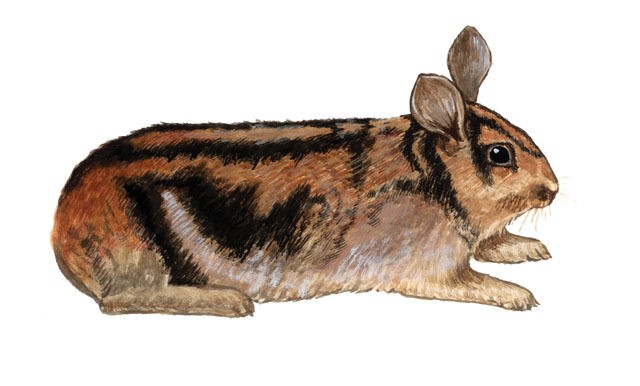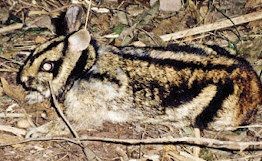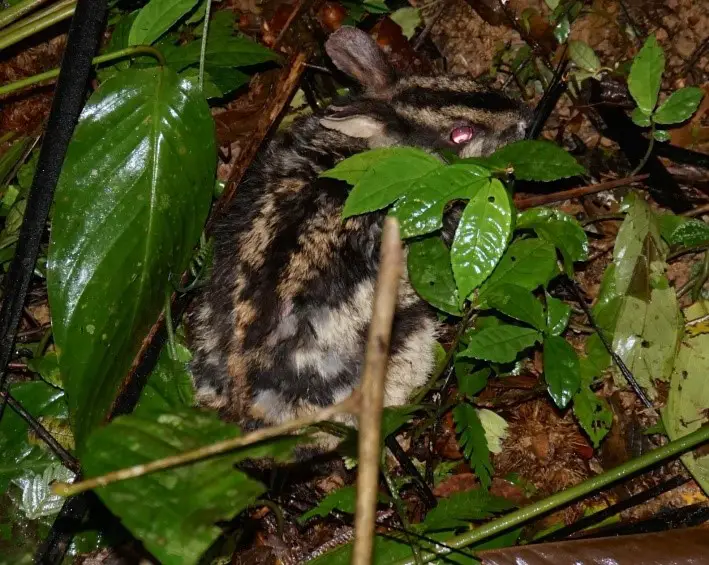Scientific Facts
| Common Name: | Sumatran striped rabbit, Sumatran short-eared rabbit, Sumatran rabbit |
| Scientific Name: | Nesolagus netscheri |
| Life Span: | Unknown |
| Size (Adult): | 40 cm long, tails 17 mm long |
| Weight (Adult) | 3.3 pounds |
| Habitat: | Rainforests |
| Body Shape: | |
| Country of Origin: | Sumatra, Indonesia |
Physical Description

The Sumatran striped rabbit is a species of rabbit found only in western Sumatra in Indonesia in the Barisan Mountains as well as the surrounding areas. This is a vulnerable rabbit species, and according to experts, it was seen only three times, captured on film by an outdoor trail camera since the 1970s.
The Sumatran rabbit is an elusive rabbit breed. The IUCN cannot classify it as threatened or endangered because it does not have enough data to do so. Because of its elusive behavior, scientists are unable to study this rabbit.
The Sumatran striped rabbit is about 40 cm long and has a tail that’s 17 mm long. It has black and brown stripes all over its body and has a red tail and rump. The rabbit’s underside is white. The fur of this rabbit is soft and dense but has harsh and long hairs on top.
History of the Breed

There is very little known about the Sumatran striped rabbit. Even local folks don’t have a name for the rabbit because they are unaware that this exists. This rabbit is known to live in burrows or abandoned holes made by other animals.
The forest where the Sumatran striped rabbit lives are cleared for timber and are also developed for coffee and tea plantations as well as human homes. The island of Java in Indonesia also experiences a surge of tourists, and this has disturbed the population of the Sumatran striped rabbit.
After being sighted in 1972, the Sumatran striped rabbit became unreported until 2000 when a specimen was photographed. There is a total of three reports of sightings of this species in the Bukit Barisan Selatan National Park. In 2007, a specimen was also photographed using a camera trap.
In September 2008, a Sumatran rabbit was also photographed by a scientist from the WWF. Another one was observed in June 2009. Finally, in 2011, examples of a Sumatran rabbit were photographed by a scientific team using only camera traps installed at the Bukit Barisan Selatan and Kerinci Seblat National Parks.
Fast Facts

There were attempts to conserve the Sumatran striped rabbit, but these efforts were quickly dismissed and unfunded because of a lack of information and reliable distribution information. This species is listed as Vulnerable according to the IUCN. Locals say that it is rarely seen and maybe uncommon in its natural habitat. The population size of this species is unknown, as well.
Reproduction in the wild

Sumatran Striped Rabbits is a wild rabbit that’s very elusive. Very little information about this rabbit’s behavior, especially reproduction is unknown as well. But if the reproductive pattern and behavior of wild rabbits are considered, then this wild specimen may have a gestation period of 38 days.
This rabbit is known for using abandoned burrows of other animals, and thus, the female may use these burrows as her nest. The female will be ready to give birth when she stays inside the burrow and will refuse to eat and drink and may not be interested in socializing. The female will use any available materials to line her nest and even her fur.
The female will give birth to three to five babies. A wild rabbit female can become pregnant three to four times a year. Like domesticated rabbits, the female Sumatran striped rabbit will nurse her babies and clean them up, but she will soon leave her nest.
Rabbit babies are born blind, deaf, and naked, very vulnerable to predators. The mother will only come back every night to nurse her babies. And just like other wild and captive kittens, baby Sumatran rabbits will open their eyes in 5 to 7 days and then wean from their mother in 10 to 12 days.
Personality and Behavior

The Sumatran striped rabbit is very skittish and will hide from predators and humans. Its elusive behavior has led to poor information and lacking support for the preservation of this species. According to photographs taken by scientists, this rabbit has a very wild behavior and extra caution is needed.
As with dealing with any wild animal or a wild rabbit, never hold, take or pet a Sumatran striped rabbit. If you luckily spot this rabbit while in the forests of Sumatra, then you must allow locals and animal agencies to take care of the individual.
Comparable Breeds
The Amami rabbit from Amami Island in Japan is a comparable rabbit breed with the Sumatran striped rabbit. Both are threatened species and are also wild and dangerous.
Care of Sumatran Striped Rabbits

Consider yourself lucky if you’re taking care of a Sumatran Striped Rabbit. This is a wild rabbit breed that’s elusive and is often very hard to describe. Therefore, the care tips we present here are all about caring for a wild rabbit overall.
To care for a captive-wild rabbit, you must make sure that your pet has the right diet or diet appropriate to its natural environment, housing or enclosure, the right vet treatment, and cage companions.`
An important part of a captive rabbit’s daily diet is hay. It will also eat rabbit pellets, which are commercially-prepared food with vitamins and minerals for your rabbit’s health. Include vegetables and fruits and food that are common in their area or natural habitat.
Place unlimited fresh water using a heavy, large dish. An inverted water bottle with a spout at the end is also a good spill-proof container to drink water from. Your pet should be eating the right food. Avoid food with pesticides, toxins, and herbicides
Captive-bred Sumatran Striped Rabbits may be a challenge to train, but it may learn to trust you if you train it early. You must constantly interact with your pet rabbit. Rabbits that grow up having constant companions and regular interactions with their handlers or owners are healthier, happier, and well-rounded animals.
Sumatran Striped Rabbits are most active in at night to forage for food. Therefore, feeding your pet, Sumatran Striped Rabbit should be done at night when they are active.
Supplies and Cages

Wild or captive-bred rabbits are very energetic, and it needs a big enclosure where it can play and run together with some companions. This enclosure should be made of wire and must have a very strong frame. The floor of the enclosure should have soft bedding and lined with good cage bedding. Use hay, wood pellets, or horse bedding to line the floor of the enclosure.
To clean the cage, use only a safe cleaner or natural materials like vinegar, baking soda, or lemon juice. Never use household cleaners because these may contain ingredients that can affect your pet’s health.
Use a separate cage if you want to take care of baby rabbits. Baby rabbits are often born naked, deaf, and blind. These must-have a warm enclosure to keep their bodies at the right temperatures. A smaller cage with a cage lamp or lighting will do well to keep the babies dry, warm, and safe.
Health Concerns

The most common condition that this wild rabbit may be affected with is common pests like mites, ticks, and fleas. These pests are naturally found in their environment. Wild rabbits are not immune to common rabbit diseases. This is why you must monitor your rabbit’s health and behavior since any change could be due to a health condition or an illness. As early as possible, take it to the vet for standard vaccinations and tests. The vet will recommend tests to assess the health and development of your pet.
Check for fur parasites, and the most common are mites, fleas, and ticks. Rabbits with these parasites usually have poor hygiene and are kept in dirty enclosures. Check for any signs of illness like poor appetite, nasal and eye discharges, constipation, loose stools, and vomiting. Symptoms like an unsteady gait, restlessness, and sleeping for extended periods could be signs of a serious condition.
Another important part of caring for rabbits and other pets is deworming. All rabbit breeds must be dewormed at once. You may use a deworming paste. Use only a pea-sized amount and place this in the rabbit’s mouth. You must follow the dose depending on your vet’s advice.
Dental Care
A rabbit’s teeth will grow even in its adult life, and sometimes, their teeth can grow so long that it can pierce their mouth and gums, causing a lot of pain. Make sure that the rabbit’s teeth don’t overgrow by offering hay because hay can grind the rabbit’s teeth naturally while the rabbit chews. Keep a close eye on your rabbit’s dental health to save on expensive dental and vet bills.
Spaying or Neutering
Rabbits are naturally promiscuous, and you must control this by spaying or neutering them. Spaying and neutering should be done while the rabbit is still young. Some vets may wait until the rabbits are six months old. Vets may also be neuter a buck at a young age to reduces aggressive behavior. If you have more questions about spaying and neutering, consult your vet.
Grooming

Sumatran Striped Rabbits have short and stiff furs and will need regular grooming. Use a sturdy brush to keep the fur clean and shiny and free from common pests. Groom the fur with a small brush at least once or twice a week.
Grooming must be more frequently during their molting period to prevent wool blocks and to keep the rabbit from ingesting their own fur. Rabbits can’t take a bath because this stresses them. Spot cleaning with a damp towel is recommended.
Availability – Where to Get One

A Sumatran Striped Rabbit is not available from any breeder. It is a threatened species of rabbit and can only be seen in its natural habitat. And despite this, it is still very elusive. If you want to care for a Sumatran rabbit, volunteer as a wildlife worker or work as a conservationist to protect this unique rabbit from extinction.
How to Care for a Sumatran Striped Rabbit
This is a summary of how to care for any wild rabbit breed. Most of the tips for caring captive or domesticated rabbits may also apply to care for a wild rabbit like a Sumatran rabbit. Always remember the four basic components of rabbit care, which are providing the correct diet, using the right housing, companionship, and vet care.
Hay is very important in their diet because this grinds their teeth, keeps their digestive system healthy, and keeps their bowel movements regular. Another food is a rabbit pellet, which has added nutrients. Include organic vegetables and fruits for a well-rounded diet. You must also give food that is found in their natural habitats such as grasses, twigs, seeds, and weeds.
Wild rabbits like the Sumatran rabbit may take a long time to train. Most rabbits will become calm, friendly, and happy pets when you take time to train and bond with them. Also, captive rabbits are social animals and will need a companion or companions of the same breed.
A rabbit can grow healthy and develop a good temperament when it socializes with you and his rabbit companions. Finally, take your pet to the vet early for standard vaccinations and tests. It must be checked for a clean bill of health before it is allowed to stay with other rabbits.
FAQs
What do Sumatran Striped Rabbits eat?
Sumatran Striped Rabbits are herbivorous, and it will eat only plants. These will eat all the parts of the plant, such as roots, seeds, weeds, flowers, and many more. Meanwhile, rabbits in captivity, this may eat commercially-prepared rabbit food, vegetables, seeds, and fruits.
Should you rescue a wild rabbit from the forest?
Never pick a wild animal such as a wild rabbit from the forest. You can’t tame it, and you can’t make it your pet because it will remain wild. If you see an injured rabbit, call animal services for help.
Are Sumatran Striped Rabbits endangered?
Yes, Sumatran Striped Rabbits are threatened rabbit species, and only a few sightings of this animal have been recorded. There is not enough data regarding the actual number of Sumatran Striped Rabbits, but experts say that it is a threatened species.
Can Sumatran Striped Rabbits swim?
There is no record or study as to the actual behavior of a Sumatran Striped Rabbit, but some say that it only lives in forests but may be able to swim, considering that there are also natural bodies of water in the forest as well. It may know how to swim well to evade predators.
Will Sumatran Striped Rabbits eat their own droppings?
Yes, just like all rabbit breeds, the Sumatran Striped Rabbit may eat its poop because these still have nutrients in them. But after the rabbit eats it droppings once, it will not do it the second time. No one knows why rabbits do this, but you can prevent this by removing their droppings as soon as they defecate.
Can you keep a Sumatran Striped Rabbit as your pet?
You can’t keep the Sumatran Striped Rabbit as a pet because it is a wild animal. Even if you play with it and train it daily, its wild side can still shine through, and thus, it is not fit to be a pet.
Are Sumatran Striped Rabbits carnivorous animals?
No, these rabbits are not carnivorous but are herbivores, which means that these won’t eat meat. This will consume plants or plant parts such as roots, bark, leaves, flowers, stems, seeds, and more.
Where do Sumatran Striped Rabbits live?
Sumatran Striped Rabbits live in holes and burrows made by other animals. They stay here all day, sleeping and waiting until its evening when they can come out to forage for food.
How do you take care of baby Sumatran Striped Rabbits?
If you want to take care of baby Sumatran Striped Rabbits, place the kits in a comfortable and warm enclosure. Feed baby rabbits soft pureed food and ensure that these are safe and warm.
Are Sumatran Striped Rabbits territorial?
Breeders say that Sumatran Striped Rabbits may also act aggressively to other males as they fight for territory. They may also do this when they are kept in small enclosures. Males can develop aggressive behavior and may become very dangerous during the breeding season. The aggressive males can bite, scratch, and hurt other males in the cage to fight for hierarchy.
Are Sumatran Striped Rabbits bites dangerous to humans?
Yes, Sumatran Striped Rabbit bites may be dangerous because the species have rabies. The rabbit’s teeth may be huge, and this can tear off skin and flesh and lead to a deep and infected wound when not properly treated.
Do Sumatran Striped Rabbits have good hearing?
The Sumatran Striped Rabbit has very good hearing. It can hear its predators from far away so it can jump and escape the threat.
Can rabbits see well while in the dark?
Yes, rabbits have good vision, especially at night. This is why some wild rabbit species prefer to look for food at night. Rabbits like the Sumatran Striped Rabbit also have a good smell and hearing, which allows them to monitor predators around their area.
What will happen when the teeth of a rabbit grow longer?
When the teeth become longer, these can pierce their mouths and gums to cause a lot of pain and affect their appetite. You can also help it by giving it hay since this can grind their teeth short as the animal chews food.
How often does your pet should visit the vet?
Rabbits must go to the vet at least twice a year. Baby rabbits must also be vaccinated from diseases as early as the rabbits open their eyes, and these should have an initial visit to a vet when they are just a few days or weeks old.
Can rabbit diseases affect humans?
Some rabbit diseases can affect only rabbits, while some affect humans. And if your rabbit is sick, take your pet to the vet as soon as you see any of these. Has your pet rabbit vaccinated from common diseases?
What do you do with abandoned baby rabbits?
If wild babies are abandoned in their nests, you should call animal service right away. You must never take baby rabbits from the wild so you can take care of pets.
Are all rabbits cannibals?
Breeders have seen mother rabbits eating their young. Experts say that this happens because the female is hungry or thirsty after she has given birth, and there is no food or liquid inside the enclosure. Some say that rabbits do this to remove any traces of tissue, blood, and smell in the nest when a baby is stillborn.
How young do vets spay or neuter a rabbit?
The decision depends on the vet as to when to spay or neuter a pet rabbit. Some bucks are neutered as early as 3 months, while some vets will wait till these are 5 to 6 months.
How many rabbits can you keep as a pet?
You can keep as many rabbits, but make sure you have a space for more rabbits as long as you have a large cage to keep these comfortable and happy. Keeping only one rabbit will make it lonely, and this can affect its health.
Will rabbits eat insects and insect eggs?
No, rabbits will not eat insects. This will eat only plant and plant parts, pellets, fruits, and vegetables. And when you give your rabbit fruits and vegetables, ensure that these are organic to avoid pesticides, toxins, and chemicals.

